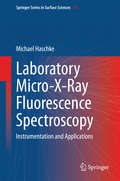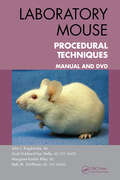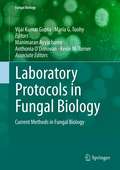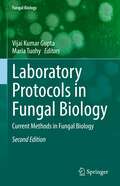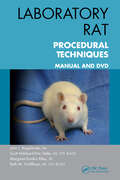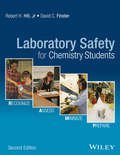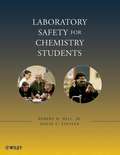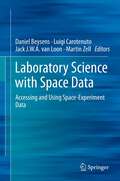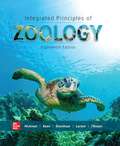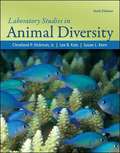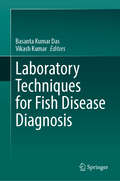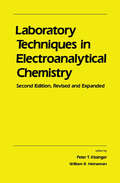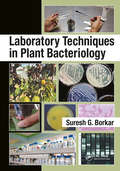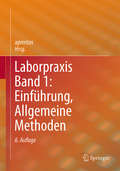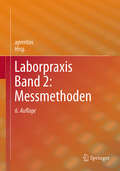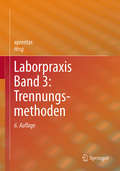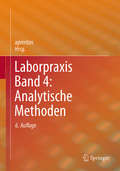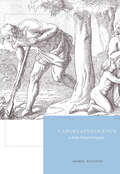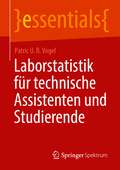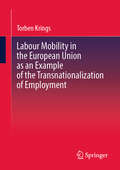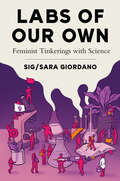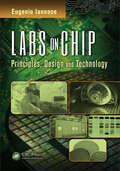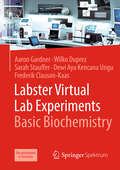- Table View
- List View
Laboratory Micro-X-Ray Fluorescence Spectroscopy
by Michael HaschkeMicro-X-ray fluorescence offers the possibility for a position- sensitive and non-destructive analysis that can be used for the analysis of non-homogeneous materials and layer systems. This analytical technique has shown a dynamic development in the last 15 years and is used for the analysis of small particles, inclusions, of elemental distributions for a wide range of different applications both in research and quality control. The first experiments were performed on synchrotrons but there is a requirement for laboratory instruments which offers a fast and immediate access for analytical results. The book discuss the main components of a µ-XRF instrument and the different measurement modes, it gives an overview about the various instruments types, considers the special requirements for quantification of non-homogeneous materials and presents a wide range of application for single point and multi-point analysis as well as for distribution analysis in one, two and three dimensions.
Laboratory Mouse Procedural Techniques: Manual and DVD
by John J. Bogdanske Scott Hubbard-Van Stelle Margaret Rankin Riley Beth SchiffmanThis combination manual and DVD provides much-needed training on the proper handling of mice used in biomedical research. The DVD includes narrated video clips that demonstrate and describe each procedural technique. The manual contains handouts with color illustrations and descriptive text for each technique, including the purpose and application
Laboratory Pathology Words and Phrases
by Sally Crenshaw PitmanBook useful for medical transcriptionists. Includes laboratory terminology, tables of bones, muscles, nerves and more.
Laboratory Procedures for Veterinary Technicians (5th edition)
by Charles M. Hendrix Margi SiroisFive American academics contribute nine chapters to an updated text for practicing veterinary technicians, veterinary assistants, and veterinary technology students. The text covers principles and procedures for laboratory diagnostics in the areas of clinical chemistry, microbiology, hematology, homeostasis, parasitology, urinalysis, immunology, and cytology. It assumes a basic understanding of the anatomy and physiology of common species. The new edition has been significantly updated with expanded information reflecting the latest developments in the veterinary clinical laboratory since publication of the 2002 edition. It includes new sections on laboratory mathematics, hematopoiesis, molecular diagnostics, and the physiologic basis of immunity; expanded information on clinical analyzers and quality assurance; and information on professional associations related to veterinary clinical pathology. Illustrated with full color and b&w photomicrographs, charts, and diagrams. Annotation ©2008 Book News, Inc., Portland, OR (booknews.com)
Laboratory Protocols in Fungal Biology
by Maria G. Tuohy Anthonia O’donovan Vijai Kumar Gupta Kevin M. Turner Manimaran AyyachamyLaboratory Protocols in Fungal Biology presents the latest techniques in fungal biology. This book analyzes information derived through real experiments, and focuses on cutting edge techniques in the field. The book comprises 57 chapters contributed from internationally recognised scientists and researchers. Experts in the field have provided up-to-date protocols covering a range of frequently used methods in fungal biology. Almost all important methods available in the area of fungal biology viz. taxonomic keys in fungi; histopathological and microscopy techniques; proteomics methods; genomics methods; industrial applications and related techniques; and bioinformatics tools in fungi are covered and complied in one book. Chapters include introductions to their respective topics, list of the necessary materials and reagents, step-by-step, readily reproducible laboratory protocols, and notes on troubleshooting. Each chapter is self-contained and written in a style that enables the reader to progress from elementary concepts to advanced research techniques. Laboratory Protocols in Fungal Biology is a valuable tool for both beginner research workers and experienced professionals.
Laboratory Protocols in Fungal Biology: Current Methods in Fungal Biology (Fungal Biology)
by Vijai Kumar Gupta Maria TuohyMycology has an integral role to play in the development of the biotechnology and biomedical sectors. It has become a subject of increasing importance as new fungi and their associated biomolecules are identified. As this discipline comes to the forefront of research in these sectors, the requirement for a consolidation of available research approaches is required. The First Edition of this book has a few basic and applied protocols. With the Second Edition, this book provides consolidated information on recent developments and the most widely used mycological methods available in the fields of biochemistry, biotechnology and microbiology. The methods outlined offer clear and concise directions to the reader and covers both standard protocols and more applied mycological methods. This book provides useful information for undergraduates, post-graduates, and specialists and researchers studying fungal biology.
Laboratory Rat Procedural Techniques: Manual and DVD
by John J. Bogdanske Scott Hubbard-Van Stelle Margaret Rankin Riley Beth SchiffmanThis combination manual and downloadable resources provide much-needed training on the proper handling of rats used in biomedical research. The downloadable resources include narrated video clips that demonstrate and describe each procedural technique. The manual contains handouts with color illustrations and descriptive text for each technique, including the purpose and application of the procedure, recommended skills, and necessary supplies. It can be used as a training resource and refresher for lab animal veterinarians, veterinary technicians, animal care staff, trainers, and research investigators and staff who work with rats.
Laboratory Safety for Chemistry Students
by Robert H. Hill Jr. David C. FinsterProvides knowledge and models of good practice needed by students to work safely in the laboratory as they progress through four years of undergraduate laboratory work Aligns with the revised safety instruction requirements from the ACS Committee on Professional Training 2015 "Guidelines and Evaluation Procedures for Bachelor's Degree Programs" Provides a systematic approach to incorporating safety and health into the chemistry curriculum Topics are divided into layers of progressively more advanced and appropriate safety issues so that some topics are covered 2-3 times, at increasing levels of depth Develops a strong safety ethic by continuous reinforcement of safety; to recognize, assess, and manage laboratory hazards; and to plan for response to laboratory emergencies Covers a thorough exposure to chemical health and safety so that students will have the proper education and training when they enter the workforce or graduate school
Laboratory Safety for Chemistry Students
by Robert H. Hill David Finster"...this substantial and engaging text offers a wealth of practical (in every sense of the word) advice...Every undergraduate laboratory, and, ideally, every undergraduate chemist, should have a copy of what is by some distance the best book I have seen on safety in the undergraduate laboratory." Chemistry World, March 2011Laboratory Safety for Chemistry Students is uniquely designed to accompany students throughout their four-year undergraduate education and beyond, progressively teaching them the skills and knowledge they need to learn their science and stay safe while working in any lab. This new principles-based approach treats lab safety as a distinct, essential discipline of chemistry, enabling you to instill and sustain a culture of safety among students. As students progress through the text, they'll learn about laboratory and chemical hazards, about routes of exposure, about ways to manage these hazards, and about handling common laboratory emergencies. Most importantly, they'll learn that it is very possible to safely use hazardous chemicals in the laboratory by applying safety principles that prevent and minimize exposures.Continuously Reinforces and Builds Safety Knowledge and Safety CultureEach of the book's eight chapters is organized into three tiers of sections, with a variety of topics suited to beginning, intermediate, and advanced course levels. This enables your students to gather relevant safety information as they advance in their lab work. In some cases, individual topics are presented more than once, progressively building knowledge with new information that's appropriate at different levels.A Better, Easier Way to Teach and Learn Lab SafetyWe all know that safety is of the utmost importance; however, instructors continue to struggle with finding ways to incorporate safety into their curricula. Laboratory Safety for Chemistry Students is the ideal solution: Each section can be treated as a pre-lab assignment, enabling you to easily incorporate lab safety into all your lab courses without building in additional teaching time.Sections begin with a preview, a quote, and a brief description of a laboratory incident that illustrates the importance of the topic.References at the end of each section guide your students to the latest print and web resources.Students will also find "Chemical Connections" that illustrate how chemical principles apply to laboratory safety and "Special Topics" that amplify certain sections by exploring additional, relevant safety issues.Visit the companion site at http://userpages.wittenberg.edu/dfinster/LSCS/.
Laboratory Science with Space Data
by Martin Zell Luigi Carotenuto Jack J.W.A. van Loon Daniel BeysensFor decades experiments conducted on space stations like MIR and the ISS have been gathering data in many fields of research in the natural sciences, medicine and engineering. The EU-sponsored Ulisse Internet Portal provides metadata from space experiments of all kinds and links to the data. Complementary to the portal, this book will serve as handbook listing space experiments by type of infrastructure, area of research in the life and physical sciences, data type, what their mission was, what kind of data they have collected and how one can access this data through Ulisse for further research. The book will provide an overview of the wealth of space experiment data that can be used for research, and will inspire academics (e.g. those looking for topics for their PhD thesis) and research departments in companies for their continued development.
Laboratory Studies In Integrated Principles Of Zoology
by Allan Larson Cleveland P. Hickman Larry S. Roberts Helen I'AnsonLaboratory Studies in Integrated Principles of Zoology textbook.
Laboratory Studies for Animal Diversity (Sixth Edition)
by Cleveland P. Hickman Lee Kats Susan KeenLaboratory Studies in Animal Diversity offers students hands-on experience in learning about the diversity of life. It provides students the opportunity to become acquainted with the principal groups of animals and to recognize the unique anatomical features that characterize each group as well as the patterns that link animal groups to each other.
Laboratory Techniques for Fish Disease Diagnosis
by Vikash Kumar Basanta Kumar DasThis book covers various aspects of fish health, disease identification and laboratory procedures. Each section of the book is detailed and includes practical information, step-by-step procedures and relevant illustrations and diagrams. The recent updates on fish disease diagnosis have been incorporated to address new techniques and technologies in the field. Fish disease diagnosis is primarily based on the color and characteristics in the image to target the infected area. It is an indispensable part of modern aquaculture, and rapid and real-time diagnosis is an essential part of the early and precise treatment of the diseases. As farmed fishes are affected by viruses, bacteria, parasites, metal pollution, and fishing damage, accurate disease diagnosis is crucial for effective management interventions. It often requires a combination of clinical expertise, advanced technology, and collaboration among healthcare professionals. This book is a comprehensive guide for students, researchers and professionals involved in fish disease diagnosis.
Laboratory Techniques in Electroanalytical Chemistry, Revised and Expanded
by Peter Kissinger William R. HeinemanThis volume provides a practical, intuitive approach to electroanalytical chemistry, presenting fundamental concepts and experimental techniques without the use of technical jargon or unnecessarily extensive mathematics. This edition offers new material on ways of preparing and using microelectrodes, the processes that govern the voltammetric behavior of microelectrodes, methods for characterizing chemically modified electrodes, electrochemical studies at reduced temperatures, and more. <P><P>The authors cover such topics as analog instrumentation, overcoming solution resistance with stability and grace in potentiostatic circuits, conductivity and conductometry, electrochemical cells, carbon electrodes, film electrodes, microelectrodes, chemically modified electrodes, mercury electrodes, and solvents and supporting electrolytes.
Laboratory Techniques in Plant Bacteriology
by Suresh G. BorkarLaboratory Techniques in Plant Bacteriology is ideal for scientists and students who seek a career in plant pathogenic bacteria. This book contains 41 chapters comprising practicable techniques from isolation of bacterial plant pathogens to their identification up to species and race/biotype level. It includes identification protocols of morphological, biochemical, immunological, and molecular-based techniques. This book comprises all technological aspects of plant bacteriological studies. Its content is ideal for graduate students and research scholars including bacteriological professionals or technicians. The book ultimately provides working technologies useful for controlling bacterial disease pathogens.
Laborpraxis Band 1: Einführung, Allgemeine Methoden
by AprentasDas vierbändige Standardwerk für die grundlegende praktische Arbeit im chemisch-pharmazeutischen Labor mit Schwerpunkt Synthesemethoden, Chromatographie und Spektroskopie liegt jetzt in der 6. völlig neu überarbeiteten Auflage vor. Es dient Berufseinsteigern als breit angelegtes Lehrmittel und erfahrenen Fachkräften als Nachschlagewerk mit übersichtlich dargestellten theoretischen Grundlagen und konkreten, erprobten Anwendungsideen. Die theoretischen Grundlagen für jedes Kapitel sind gut lesbar abgefasst und unterstützen das Verständnis für praktische Arbeiten und Gerätefunktionen. Zu jedem Kapitel gibt es Hinweise auf vertiefende und weiterführende Literatur. Arbeitssicherheit und –hygiene sowie die zwölf Prinzipien der nachhaltigen Chemie finden neben den entsprechenden Kapiteln Beachtung. Die im Buch erwähnten praktischen Grundlagen gründen auf Gegebenheiten in der chemisch-pharmazeutischen Industrie in der Schweiz. Sie finden im gesamten deutschsprachigen Raum Anwendung, auch in verwandten Arbeitsgebieten wie biochemischen, klinischen, werkstoffkundlichen oder universitären Laboratorien. Die Laborpraxis eignet sich für den Einsatz in der Grund- und in der Weiterbildung von Fachpersonal. Der Inhalt entspricht den aktuellen Anforderungen der Bildungsverordnung und des Bildungsplanes zum Beruf Laborantin / Laborant mit eidgenössischem Fähigkeitszeugnis (EFZ), welche vom Staatssekretariat für Bildung, Forschung und Innovation (SBFI) in Bern verordnet wurden. Damit steht den Lernenden eine gute Grundlage für die Vorbereitung auf das Qualifikationsverfahren (QV) zur Verfügung; Expertinnen und Experten stützen ihre persönlichen Vorbereitungsarbeiten und ihre fachlichen Beurteilungen auf dieses Buch. Band 1 und Band 2 behandeln ausführlich die Grundlagen der Laborarbeit und ausgewählte Messtechniken. Band 3 ist auf präparative und analytische Trennungsmethoden, Band 4 auf nasschemische und spektroskopische Analysemethoden fokussiert. Sowohl konventionelle Methoden als auch modernste Techniken finden Erwähnung. Der Fokus auf beständig gültigen Prinzipien erlaubt auch neue, nicht erwähnte Techniktrends zu verstehen sowie die tägliche Arbeit im chemisch-pharmazeutischen Labor zu reflektieren.
Laborpraxis Band 2: Messmethoden
by AprentasDas vierbändige Standardwerk für die grundlegende praktische Arbeit im chemisch-pharmazeutischen Labor mit Schwerpunkt Synthesemethoden, Chromatographie und Spektroskopie liegt jetzt in der 6. völlig neu überarbeiteten Auflage vor. Es dient Berufseinsteigern als breit angelegtes Lehrmittel und erfahrenen Fachkräften als Nachschlagewerk mit übersichtlich dargestellten theoretischen Grundlagen und konkreten, erprobten Anwendungsideen. Die theoretischen Grundlagen für jedes Kapitel sind gut lesbar abgefasst und unterstützen das Verständnis für praktische Arbeiten und Gerätefunktionen. Zu jedem Kapitel gibt es Hinweise auf vertiefende und weiterführende Literatur. Arbeitssicherheit und –hygiene sowie die zwölf Prinzipien der nachhaltigen Chemie finden neben den entsprechenden Kapiteln Beachtung. Die im Buch erwähnten praktischen Grundlagen gründen auf Gegebenheiten in der chemisch-pharmazeutischen Industrie in der Schweiz. Sie finden im gesamten deutschsprachigen Raum Anwendung, auch in verwandten Arbeitsgebieten wie biochemischen, klinischen, werkstoffkundlichen oder universitären Laboratorien. Die Laborpraxis eignet sich für den Einsatz in der Grund- und in der Weiterbildung von Fachpersonal. Der Inhalt entspricht den aktuellen Anforderungen der Bildungsverordnung und des Bildungsplanes zum Beruf Laborantin / Laborant mit eidgenössischem Fähigkeitszeugnis (EFZ), welche vom Staatssekretariat für Bildung, Forschung und Innovation (SBFI) in Bern verordnet wurden. Damit steht den Lernenden eine gute Grundlage für die Vorbereitung auf das Qualifikationsverfahren (QV) zur Verfügung; Expertinnen und Experten stützen ihre persönlichen Vorbereitungsarbeiten und ihre fachlichen Beurteilungen auf dieses Buch. Band 1 und Band 2 behandeln ausführlich die Grundlagen der Laborarbeit und ausgewählte Messtechniken. Band 3 ist auf präparative und analytische Trennungsmethoden, Band 4 auf nasschemische und spektroskopische Analysemethoden fokussiert. Sowohl konventionelle Methoden als auch modernste Techniken finden Erwähnung. Der Fokus auf beständig gültigen Prinzipien erlaubt auch neue, nicht erwähnte Techniktrends zu verstehen sowie die tägliche Arbeit im chemisch-pharmazeutischen Labor zu reflektieren.
Laborpraxis Band 3: Trennungsmethoden
by AprentasDas vierbändige Standardwerk für die grundlegende praktische Arbeit im chemisch-pharmazeutischen Labor mit Schwerpunkt Synthesemethoden, Chromatographie und Spektroskopie liegt jetzt in der 6. völlig neu überarbeiteten Auflage vor. Es dient Berufseinsteigern als breit angelegtes Lehrmittel und erfahrenen Fachkräften als Nachschlagewerk mit übersichtlich dargestellten theoretischen Grundlagen und konkreten, erprobten Anwendungsideen. Die theoretischen Grundlagen für jedes Kapitel sind gut lesbar abgefasst und unterstützen das Verständnis für praktische Arbeiten und Gerätefunktionen. Zu jedem Kapitel gibt es Hinweise auf vertiefende und weiterführende Literatur. Arbeitssicherheit und –hygiene sowie die zwölf Prinzipien der nachhaltigen Chemie finden neben den entsprechenden Kapiteln Beachtung. Die im Buch erwähnten praktischen Grundlagen gründen auf Gegebenheiten in der chemisch-pharmazeutischen Industrie in der Schweiz. Sie finden im gesamten deutschsprachigen Raum Anwendung, auch in verwandten Arbeitsgebieten wie biochemischen, klinischen, werkstoffkundlichen oder universitären Laboratorien.Die Laborpraxis eignet sich für den Einsatz in der Grund- und in der Weiterbildung von Fachpersonal. Der Inhalt entspricht den aktuellen Anforderungen der Bildungsverordnung und des Bildungsplanes zum Beruf Laborantin / Laborant mit eidgenössischem Fähigkeitszeugnis (EFZ), welche vom Staatssekretariat für Bildung, Forschung und Innovation (SBFI) in Bern verordnet wurden. Damit steht den Lernenden eine gute Grundlage für die Vorbereitung auf das Qualifikationsverfahren (QV) zur Verfügung; Expertinnen und Experten stützen ihre persönlichen Vorbereitungsarbeiten und ihre fachlichen Beurteilungen auf dieses Buch. Band 1 und Band 2 behandeln ausführlich die Grundlagen der Laborarbeit und ausgewählte Messtechniken. Band 3 ist auf präparative und analytische Trennungsmethoden, Band 4 auf nasschemische und spektroskopische Analysemethoden fokussiert. Sowohl konventionelle Methoden als auch modernste Techniken finden Erwähnung. Der Fokus auf beständig gültigen Prinzipien erlaubt auch neue, nicht erwähnte Techniktrends zu verstehen sowie die tägliche Arbeit im chemisch-pharmazeutischen Labor zu reflektieren.
Laborpraxis Band 4: Analytische Methoden
by AprentasDas vierbändige Standardwerk für die grundlegende praktische Arbeit im chemisch-pharmazeutischen Labor mit Schwerpunkt Synthesemethoden, Chromatographie und Spektroskopie liegt jetzt in der 6. völlig neu überarbeiteten Auflage vor. Es dient Berufseinsteigern als breit angelegtes Lehrmittel und erfahrenen Fachkräften als Nachschlagewerk mit übersichtlich dargestellten theoretischen Grundlagen und konkreten, erprobten Anwendungsideen. Die theoretischen Grundlagen für jedes Kapitel sind gut lesbar abgefasst und unterstützen das Verständnis für praktische Arbeiten und Gerätefunktionen. Zu jedem Kapitel gibt es Hinweise auf vertiefende und weiterführende Literatur. Arbeitssicherheit und –hygiene sowie die zwölf Prinzipien der nachhaltigen Chemie finden neben den entsprechenden Kapiteln Beachtung. Die im Buch erwähnten praktischen Grundlagen gründen auf Gegebenheiten in der chemisch-pharmazeutischen Industrie in der Schweiz. Sie finden im gesamten deutschsprachigen Raum Anwendung, auch in verwandten Arbeitsgebieten wie biochemischen, klinischen, werkstoffkundlichen oder universitären Laboratorien. Die Laborpraxis eignet sich für den Einsatz in der Grund- und in der Weiterbildung von Fachpersonal. Der Inhalt entspricht den aktuellen Anforderungen der Bildungsverordnung und des Bildungsplanes zum Beruf Laborantin / Laborant mit eidgenössischem Fähigkeitszeugnis (EFZ), welche vom Staatssekretariat für Bildung, Forschung und Innovation (SBFI) in Bern verordnet wurden. Damit steht den Lernenden eine gute Grundlage für die Vorbereitung auf das Qualifikationsverfahren (QV) zur Verfügung; Expertinnen und Experten stützen ihre persönlichen Vorbereitungsarbeiten und ihre fachlichen Beurteilungen auf dieses Buch. Band 1 und Band 2 behandeln ausführlich die Grundlagen der Laborarbeit und ausgewählte Messtechniken. Band 3 ist auf präparative und analytische Trennungsmethoden, Band 4 auf nasschemische und spektroskopische Analysemethoden fokussiert. Sowohl konventionelle Methoden als auch modernste Techniken finden Erwähnung. Der Fokus auf beständig gültigen Prinzipien erlaubt auch neue, nicht erwähnte Techniktrends zu verstehen sowie die tägliche Arbeit im chemisch-pharmazeutischen Labor zu reflektieren.
Labors of Innocence in Early Modern England
by Joanna PicciottoIn seventeenth-century England, intellectuals of all kinds discovered their idealized self-image in the Adam who investigated, named, and commanded the creatures. Reinvented as the agent of innocent curiosity, Adam was central to the project of redefining contemplation as a productive and public labor. It was by identifying with creation’s original sovereign, Joanna Picciotto argues, that early modern scientists, poets, and pamphleteers claimed authority as both workers and “public persons.” Tracking an ethos of imitatio Adami across a wide range of disciplines and devotions, Picciotto reveals how practical efforts to restore paradise generated the modern concept of objectivity and a novel understanding of the author as an agent of estranged perception. Finally, she shows how the effort to restore Adam as a working collective transformed the corpus mysticum into a public. Offering new readings of key texts by writers such as Robert Hooke, John Locke, Andrew Marvell, Joseph Addison, and most of all John Milton, Labors of Innocence in Early Modern England advances a new account of the relationship between Protestantism, experimental science, the public sphere, and intellectual labor itself.
Laborstatistik für technische Assistenten und Studierende (essentials)
by Patric U. VogelIn diesem essential wird die Anwendung von statistischen Analysen von normalverteilten Daten im Laboralltag dargestellt. Hierzu zählen die Berechnung von Mittelwert und Standardabweichung sowie die Erstellung von einfachen grafischen Abbildungen. Im Anschluss werden Tests auf Ausreißer und Normalverteilung sowie Stichprobenberechnungen anhand einfacher Beispiele vorgestellt. Abschließend erlernen die Leser*innen den Vergleich von Datengruppen mittels t-test und ANOVA, das Erkennen von Zusammenhängen mittels linearer Regression und Korrelation sowie die Anwendung von Konfidenzintervallen. Zusätzlich werden übliche Fehlerquellen bei der Anwendung statistischer Methoden erklärt.
Labour Mobility in the European Union as an Example of the Transnationalization of Employment
by Torben KringsThis book examines the changing significance of intra-European labor mobility in the 21st century. The focus is on the driving forces, the labor market effects and the regulation of this mobility. It is shown that there is a demand for workers with different qualifications in the "post-industrial" societies of Western Europe. This demand is primarily met by migration from the enlarged EU. However, this is no longer traditional labor migration, but the mobility of EU citizens. This brings with it new opportunities, but also challenges in a transnational mobility space, which is also a space of inequality.
Labs of Our Own: Feminist Tinkerings with Science
by Sig / GiordanoFrom climate change to COVID-19 to reproductive justice, there has been deep political polarization around science. Labs of Our Own provides a unique entry point into these twenty-first-century science wars by focusing on our affective relationships to science. The book delves into various sites where scientists, teachers, artists, and activists claim to create more democratic access to science—from DIY biology community labs to feminist classrooms to activist science practitioners. The reader will find that these claims for and attempts at democratic sciences not only impact what counts as science and who counts as a scientist but reconfigure who is included in the proper public. Instead of arguing for a knee-jerk defense of science against right-wing attacks, Labs of Our Own builds the case for a feminist, antiracist, decolonial, queer science tinkering practice that intentionally, politically, and ethically acts to produce new challenges to the definition and boundaries of the human.
Labs on Chip: Principles, Design and Technology (Devices, Circuits, and Systems)
by Eugenio IannoneLabs on Chip: Principles, Design and Technology provides a complete reference for the complex field of labs on chip in biotechnology. Merging three main areas— fluid dynamics, monolithic micro- and nanotechnology, and out-of-equilibrium biochemistry—this text integrates coverage of technology issues with strong theoretical explanations of design techniques. Analyzing each subject from basic principles to relevant applications, this book: Describes the biochemical elements required to work on labs on chip Discusses fabrication, microfluidic, and electronic and optical detection techniques Addresses planar technologies, polymer microfabrication, and process scalability to huge volumes Presents a global view of current lab-on-chip research and development Devotes an entire chapter to labs on chip for genetics Summarizing in one source the different technical competencies required, Labs on Chip: Principles, Design and Technology offers valuable guidance for the lab-on-chip design decision-making process, while exploring essential elements of labs on chip useful both to the professional who wants to approach a new field and to the specialist who wants to gain a broader perspective.
Labster Virtual Lab Experiments: Basic Biochemistry
by Sarah Stauffer Aaron Gardner Wilko Duprez Dewi Ayu Kencana Ungu Frederik Clauson-KaasThis textbook helps you to prepare for your next exams and practical courses by combining theory with virtual lab simulations. The “Labster Virtual Lab Experiments” series gives you a unique opportunity to apply your newly acquired knowledge in a learning game that simulates exciting laboratory experiments. Try out different techniques and work with machines that you otherwise wouldn’t have access to.In this book, you’ll learn the fundamental concepts of basic biochemistry focusing on:Ionic and Covalent BondsIntroduction to Biological MacromoleculesCarbohydratesEnzyme KineticsIn each chapter, you’ll be introduced to one virtual lab simulation and a true-to-life challenge. Following a theory section, you’ll be able to play the relevant simulation that includes quiz questions to reinforce your understanding of the covered topics. 3D animations will show you molecular processes not otherwise visible to the human eye.If you have purchased a printed copy of this book, you get free access to five simulations for the duration of six months. If you’re using the e-book version, you can sign up and buy access to the simulations at www.labster.com/springer.If you like this book, try out other topics in this series, including “Basic Biology”, “Basic Genetics”, and “Genetics of Human Diseases”.
